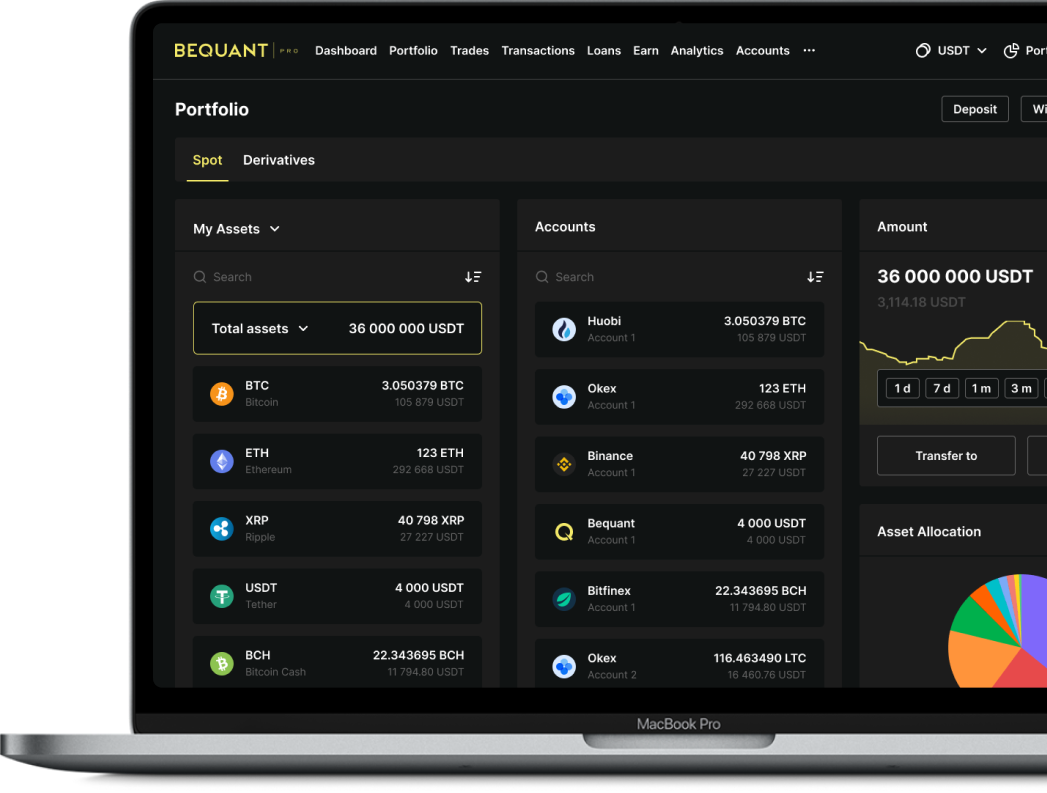Recession Risks

Summary:
Recession is in the air, driven by the jump in oil prices and the general commodity complex. At $120, demand destruction kicks in. The market is not yet pricing in a complete disruption of Russian oil exports, as that would take us closer to $170 and most certainly push us into recession. Crypto recovered ground over the last few days of February on a short squeeze. While flows from Russia, where crypto adoption is high, did jump, they were small relative to the overall market. It is another encouraging example of grassroots adoption of digital assets. We also take a closer look at Luna, which has had quite a rip on its BTC reserve announcement and the burning mechanism versus UST, the algorithmic stablecoin of the ecosystem.
Macro
INFLATION: PUBLIC ENEMY NO.1
We hadn’t seen a jump in oil prices of this magnitude since right before the GFC. This puts the Fed, already in a tricky situation trying to engineer a soft landing while taming inflation, in a bad spot. The bond market already senses this, as the differential between 2 yr and 10 yr rates continues to narrow to levels last seen in March 2020 (< 30 basis points), indicating a growing risk of recession. We can also see the risk aversion as the USD strengthens in tandem with commodities, which is a rare thing.
Rate hike expectations, which were overly aggressive, have been walked back to five hikes from seven, with Fed Chairman Powell testifying to Congress that he will propose a 25 bp move in two weeks time, leaving the door open for 50 bps moves in future. With the White House focused on combating inflation for its own political survival, the risk is that the Fed will go overboard and strangle the economy. President Biden made it clear during his State of the Union address that inflation is public enemy number one.
One area of the US economy where we may start to see some slowing of inflation is housing. MBA mortgage purchase apps came in at -1.8% W/W and -8.7% Y/Y and the index dropped to its lowest level since May 2020. The combination of higher rates and low inventory has started to become a headwind for demand.
The latest economic data coming out of the US shows weakness ahead, with the Atlanta Fed Nowcast at 0% growth sequentially and the Chicago Purchasing Managers Index slumping. The PMI leads corporate margins by six months, which will be pressured by rising costs.
|
What is the Atlanta Fed Nowcast? GDPNow is not an official forecast of the Atlanta Fed. Rather, it is a running estimate of real GDP growth based on available economic data for the current quarter. There are no subjective adjustments made to GDPNow—the estimate is based solely on the mathematical results of the model. |
Atlanta Fed Nowcast at 0% Quarter over Quarter
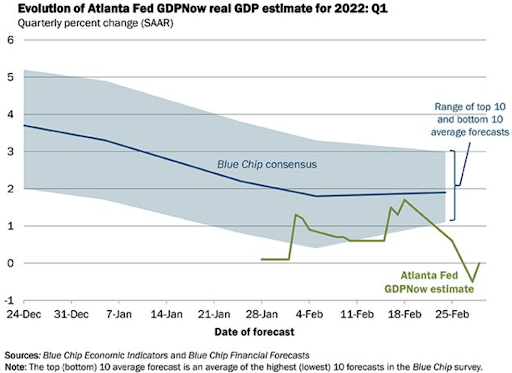
The Chicago PMI slumps, hinting at a margin squeeze ahead for companies
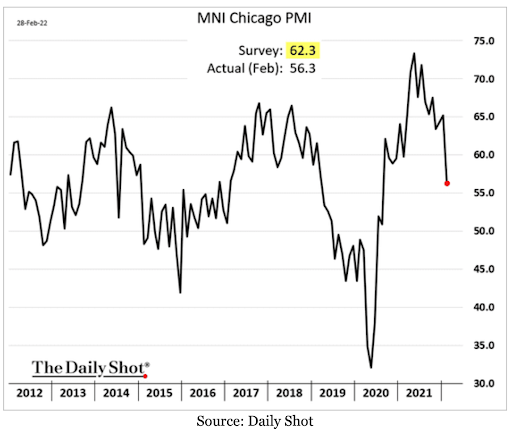
ADDICTED TO THE BLACK STUFF
A key uncertainty at the moment is whether Russian oil will keep flowing. Some Democrats are pushing for a ban, with the Germans balking given their overreliance on Russian gas. The country’s energy sales were excluded from the proposed sanctions as that amount of oil, 13% of global production, exiting the system would most certainly drag us into recession. However, Urals barrels are trading at a large discount as some buyers are wary of purchasing them, with reports that as much as 70% of Russian production is affected.
WTI crude is now up over 40% year to date, to $113 as of Friday. Such a rapid rise in oil prices in such short order heightens the risk of recession, which the markets are starting to price in. Some analysts are estimating that WTI above $120 will lead to demand destruction, which would be needed to offset the supply shock. Looking at oil prices in inflation-adjusted terms, they would have to rise to $150-170 to reflect the tighter environment as per work done by Macro Compass.
WTI Oil price spikes to levels last seen in 2011, Russia produces 13% of the world’s oil
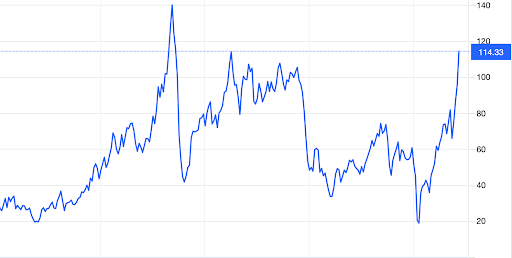
Source: TradingEconomics
Oil is the main component of the commodity complex, but price rises are broadening out to other Russian exports, from grains to nickel to palladium
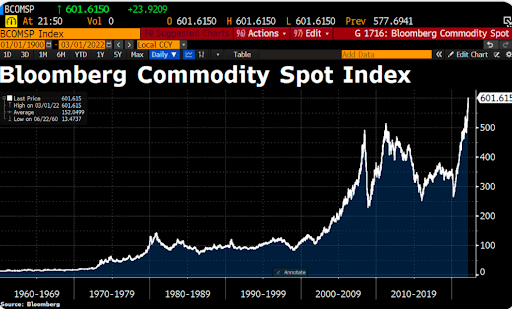
Russia exports 80% of its gas to the rest of the world. Europe is most vulnerable as it gets 40% of its gas from the country and was already experiencing an energy crisis prior to the invasion. Eurozone Flash CPI accelerated to +5.8% Y/Y in February, which is a huge jump from January’s reading of +5.1% Y/Y.
The US has flipped from self-sufficiency in oil to importing 8.5 million barrels of oil per day, with 7% of that coming from Russia. Russia also controls 25% of the global wheat production, if you include Ukraine, and is the largest fertilizer exporter globally. Metals like copper and aluminium come into the crisis with low inventory levels, not helping matters.
Energy was already pressuring headline inflation as seen in Europe and the Euro hates it
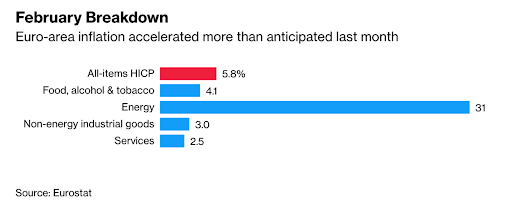
Assuming people buy the stuff, oil prices are a boon to Russia’s export receipts. In 2021, the country posted its largest-ever current account balance at $120 bn, also helped by lower imports from abroad. As energy is 40% of exports, the higher oil prices go and the ruble falls, the higher these numbers will go.
Higher oil prices and a lower ruble boost Russia’s export revenues
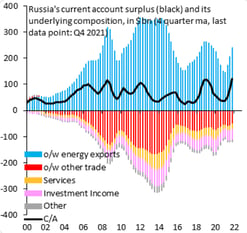
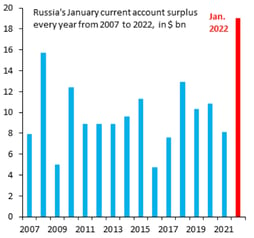
Source: Robin Brooks
NOT YOUR VAULT, NOT YOUR RESERVES
In an unprecedented move, the West is attempting to freeze some of Russia’s $640 bn buffer of reserves. For years now, the country has been de-dollarizing, buying gold, euros and yuans but it is possible that they may not be able to access their dollars, euros and yen. There was also a selective ban from Swift, with only some banks affected with the intention not to disrupt the energy market.
|
What is SWIFT? SWIFT is a messaging network created in 1973 that financial institutions use to securely transmit information and instructions through a standardized system of codes. It settles 37 million |
Where is Russia’s stash? Gold and Chinese holdings are out of the reach of sanctions
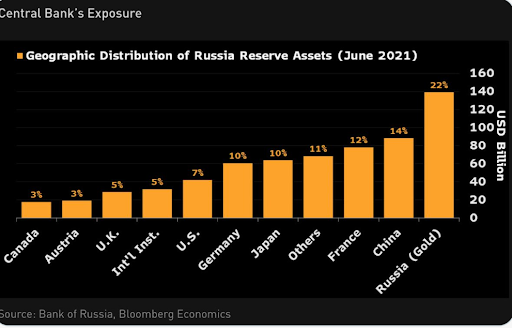
SANCTIONS BITE
The ruble fell by 29% in the last week, with losses accelerating over last weekend as Western nations announced harsher sanctions. The Russian Central Bank reacted by almost doubling interest rates to 20%, the highest in almost two decades, to stem capital flight. They also shut the local market for a period not seen since 1998, ordered companies to sell 80% of their foreign reserves, injected 733 bn rubles into the local banking system and banned coupon payments for foreign investors holding rouble-denominated sovereign debt. Russian companies were also barred from paying dividends to overseas shareholders.
The London Stock Exchange suspended trading in 27 companies with strong links to Russia, including Gazprom, Lukoil, Novatek. Rosneft and Sberbank, with 430 bn pounds erased from London-listed Russian shares, as they lost almost all of their value.
Crypto
THIN TRADING AND A SHORT SQUEEZE
Liquidity in digital assets continued to thin out in February on heightened risk aversion, with the basis spread collapsing and turning slightly negative at one point. For the week, the digital complex was up over 3% as of Friday, with BTC faring better (+5.4%) than the US equity market. Luna (+26%), Cosmos (+24%), Near (+26%), Monero (+12%), Waves (+95%), Thor (+56%), Zcash (18%) and Anchor (31%) stood out.
Traders were leaning negative, as indicated by funding rates, ahead of the harsher sanctions announced on the 28th, creating a short squeeze on expectations of flows coming from Russians seeking an exit strategy (surveys have shown 12% hold crypto).
Buyers of BTC at the top last October and November have been flushed out and the coins redistributed to the 38k level. The distribution is much more even than before the May sell-off when a lot of buyers came in at the top. At the moment, net realized loss has not been large versus the January sell-off or even last summer. We will have to see whether buyers at the 40-50k level capitulate.
BTC and ETH adjusted on-chain volume declined by 6% last month

The basis spread on Binance, the most liquid market, briefly turned negative this week and is bouncing along the bottom.
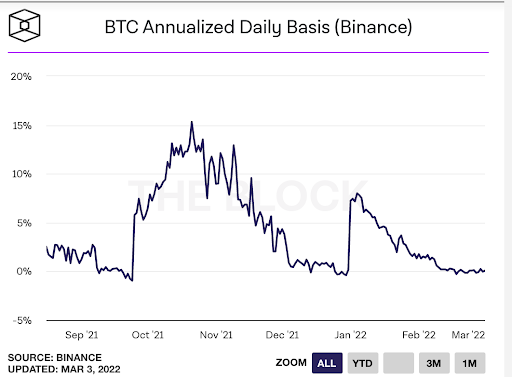
Source: The Block
BTC funding rates show a lack of conviction
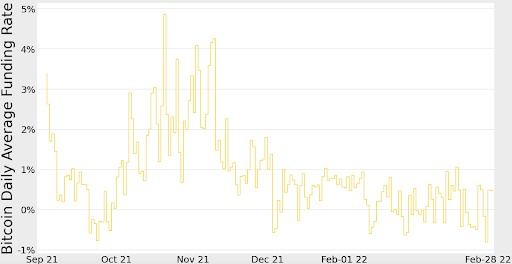
Sellers are not realizing large losses yet
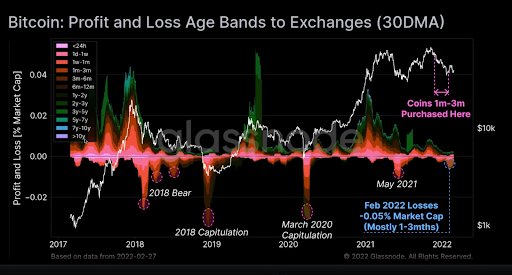
Source: Glassnode
Miner revenue fell by 13% for BTC to $1bn and 15% for ETH to $1.2bn, with ETH continuing to surpass BTC for the 10th month in a row
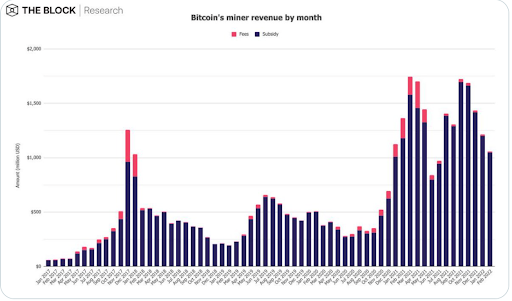
CRYPTO AS A LIFELINE
In a trend we have noticed in other parts of the world, including most recently, Turkey, the Ukraine government and people are turning to digital assets to raise funds and protect their savings.
As of Thursday, the government of Ukraine raised over $50 million in donations of BTC, ETH and Polkadot and even a CryptoPunk donation. Binance alone gave $10 mn. The country announced an airdrop for donors but then cancelled it, saying they would conduct an NFT campaign instead.
The spike in BTC/Ruble volumes after the invasion was notable.

Source: The Block
Much of the ruble flow into crypto centered around Tether, the only stablecoin option for ruble-denominated trade on exchanges like Binance.

Premiums for RUB pairs emerged early in the week and still existed for hryvnia trading pairs with BTC, USDT and ETH to close the week. According to Bitcoin.com, the all-time high BTC-RUB premium was $7,853 over the global average on Monday.
EBAY MAY ADD CRYPTO PAYMENTS SOON AS SALES SLOW
Ebay, which aspires to be the marketplace for Gen-Z and millennials, may add cryptocurrencies as a means of payment and could make an announcement as early as its investor day on March 10, said its CEO.
The platform directly manages $85 bn in payments, with GooglePay, ApplePay and buy now, pay later Afterpay and there has been speculation around digital assets for several years. This area has been an added source of revenues as core sales fell on tough pandemic comps. The company has $10 bn in revenues per year versus Amazon's $386 bn.
NFTs are already being traded on eBay so it seems like crypto would be a natural evolution. Just like with physical goods, though, there are plenty of imitation products on the platform, such as the Sweet Ape Yacht club collection, which looks just like the original Bored Apes but at a fraction of the price.
Regulation
CENTRALIZED EXCHANGES CAUGHT IN THE MIDDLE ON UKRAINE
Ukraine's Vice Prime Minister and Minister of Digital Transformation asked crypto exchanges to block addresses of Russian users via Twitter. But some of the major exchanges pushed back saying they would not do so except for sanctioned individuals. It did bring home that ultimately, centralized exchanges are subject to the regulators’ directives.
RUSSIA CAN’T EVADE SANCTIONS VIA CRYPTO
Several US Democratic Senators are using Ukraine as an opportunity to rail against crypto, requesting the Treasury define its strategy for monitoring and enforcing crypto sanctions. This included Elizabeth Warren, who has been vocal in her opposition to crypto. Sanctions encompass all means of payment, so US individuals are not allowed to transact with any Specially Designated Persons at all, crypto or not. However, they are free to use other channels, such as the Chinese payment system which may ultimately weaken the SWIFT system.
In addition, the liquidity of digital assets is too thin to disguise the volumes that a sovereign state the size of Russia would require, it would not be easy to hide. A Chainaysis report stated that Iran was earning $1 bn a year from selling mined bitcoin, for example which is not a significant amount.
EU PROPOSAL TO BAN PROOF OF WORK IS SCRAPPED
A European Union proposal to prohibit crypto services reliant on environmentally unsustainable consensus mechanisms like proof-of-work starting in January 2025 has been indefinitely postponed after strong opposition.
CHINA RULES CRYPTO IS A CRIME
Doubling down on the harsh approach to crypto, China's Supreme Court ruled Thursday that some virtual asset transactions can constitute "illegal fundraising". The court now formally designates them as a crime meaning suspects can be prosecuted and receive fines or even prison sentences.
SEC TARGETS NFTS
According to a Bloomberg report, the SEC has moved on from crypto lending products to evaluating whether fractionalized NFTs are in fact securities. Throughout the last few months, attorneys from the SEC have reportedly sent subpoenas demanding information on specific NFTs and other token offerings. Hester Peirce, a crypto friendly SEC official, had already warned last year that fractionalized NFTs could be breaking the law.
FLOKI INU ADS BANNED
The U.K.'s Advertising Standards Authority (ASA) banned ads for a meme-based crypto named after Elon Musk's shiba inu dog, saying they were "irresponsible." The Floki Inu coin was advertised on London's buses and Tube last year under the slogan "Missed Doge? Get Floki."
DeFi / NFTs / Metaverse
LUNA MOONS
LUNA is one of the two tokens issued by Terra, an algorithmic stablecoin protocol that uses dollar-pegged stablecoin UST to build a global payments system. $29 bn is currently staked, earning almost 7% yields. It is one of the best performing tokens over the last two years.
The coin continues to rip after last week’s announcement that Terra's stablecoin, TerraUSD (UST) will be backed by a $1 bn Bitcoin reserve. Unlike other centralized stable coins, UST isn't backed by U.S. dollars, but is fixed to the U.S. dollar via a minting and burning process for LUNA. If the price of UST falls off its peg and goes lower than $1 per token, UST can be swapped for LUNA (which is minted) and sold for $1, providing arbitrage gains for investors. The inverse is true on the upside, where higher demand for UST means more LUNA is burned, reducing LUNA's supply and increasing its price.
The introduction of this Bitcoin reserve may reduce volatility as it is lower beta in relation to Terra's existing ecosystem, and users can also swap out UST to Bitcoin if conditions are favorable.
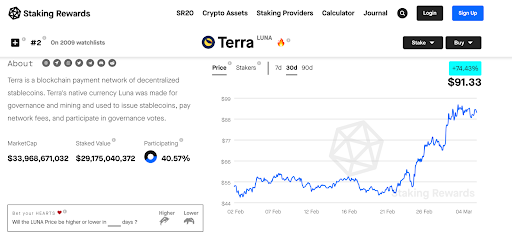
Source: Staking Rewards
CRYPTOPUNK LOANS
In what may be the largest-ever NFT-backed loan, an anonymous borrower took out an $8 million loan collateralized by their collection of 101 CryptoPunks.The loan has an APR of 10% and a 30-day duration. It was facilitated by liquidity scaling solution MetaStreet on lending platform NFTfi.
Until next week!
Disclaimer: The views expressed in this newsletter are my own and not intended as financial advice or a recommendation, but only for informational purposes. You should carry out your own independent research or consult a financial adviser if you are unsure. Please also be advised that I hold investments in some of the assets mentioned in this report, including digital assets, equities and ETFs.
